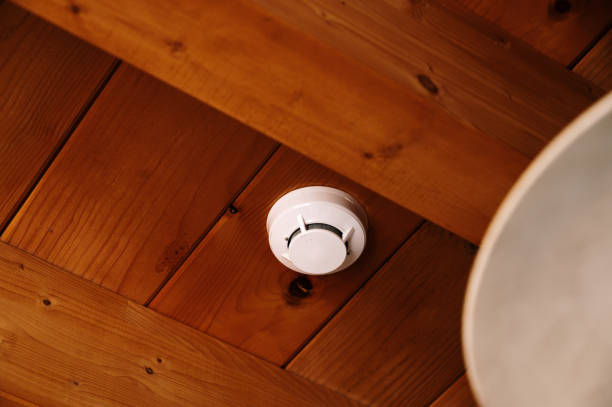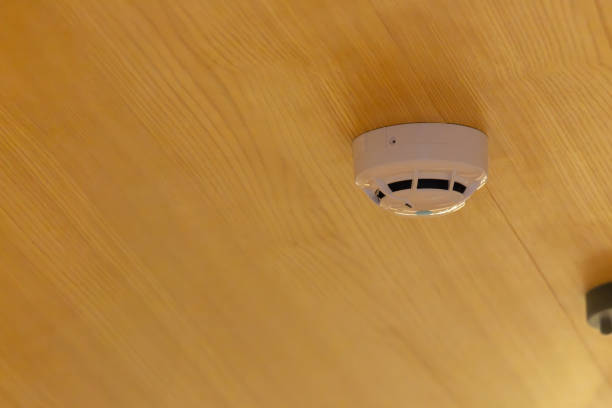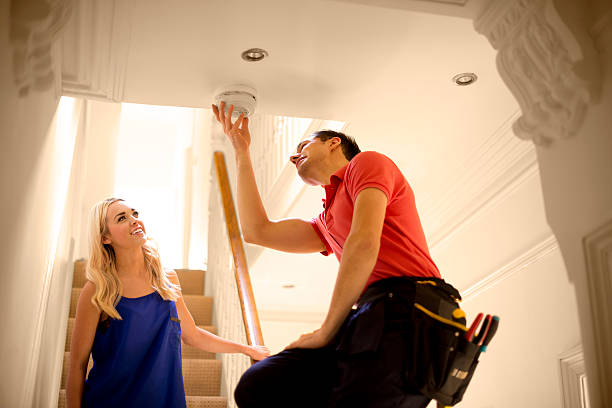Ensuring your smoke detectors are in perfect working order is not just a household chore; it’s a critical safety measure that can save lives. A functional smoke detector provides an early warning in the event of a fire, giving you and your family precious time to escape. But how do you know if it’s working? This guide provides a comprehensive overview of how to test smoke detector units, from basic button tests to understanding advanced methods and maintenance schedules. Regularly performing a how to test smoke detector check is paramount for home safety.
The Importance of Regularly Testing Your Smoke Detector
Before diving into the “how-to,” let’s briefly touch upon the “why.” Fires can start unexpectedly and spread rapidly. According to the National Fire Protection Association (NFPA), the risk of dying in a reported home fire is cut by more than half in homes with working smoke alarms.
However, a smoke alarm can only protect you if it’s functioning correctly. This is why understanding how to test smoke detector devices and performing these tests diligently is so crucial. Dead batteries, dust accumulation, or simply age can render a detector useless. Don’t wait for an emergency to discover your first line of defense has failed; make learning how to test smoke detector units a priority.
The Simplest Method: Using the Test Button
The most common and universally recommended method for a quick check of your smoke detector is by using its built-in test button. This is the foundational step in knowing how to test smoke detector units. “Press and hold the test button on the smoke detector. It can take a few seconds to begin, but a loud, ear-piercing siren should emanate from the smoke detector while the button is pressed. If the sound is weak or nonexistent, replace your batteries.” This straightforward advice highlights the immediate feedback you should expect.
The primary purpose of the test button is to verify that the alarm’s circuitry, electronics, and sounder are operational. As one source puts it, “Pressing the test/hush button simulates the effect of the smoke and/or heat and is therefore the best way to ensure the alarm is operating correctly.” Most manufacturers recommend pressing and holding the test button for at least five to ten seconds until you hear the beeps or siren. This ensures a “complete test of your alarm(s).” If you’re unsure about the specifics for your model, always consult the manufacturer’s instructions. Understanding this basic how to test smoke detector function is your first step towards a safer home. If your detector starts beeping intermittently and it’s not the test sequence, you might need to investigate further; our resources at smokedetectorbeeping.com can help troubleshoot such issues.
Step-by-Step Guide: How to Test Smoke Detector Units Thoroughly
While pressing the button is simple, a more systematic approach can ensure everyone in your household is prepared and that the alarm is effective throughout your home. Here’s a more detailed procedure for how to test smoke detector systems.
Step 1: Alert Your Household
“Alert family members that you will be testing the alarm. Smoke detectors have a high-pitched alarm that may frighten small children, so you’ll want to let everyone know you plan to test the alarms to help avoid scaring anyone.” This is a considerate and important first step. The sound is designed to be jarring, so a warning is essential, especially for young children, pets, or individuals sensitive to loud noises.
Step 2: Check for Audibility Across Your Home
“Station a family member at the furthest point away from the alarm in your home. This can be critical to help make sure the alarm can be heard everywhere in your home.” If the sound is low, muffled, or weak in certain areas, you may need to install additional detectors or relocate existing ones. The goal of knowing how to test smoke detector units is to ensure the alert is effective everywhere.
Step 3: Perform the Test and Assess
Press and hold the test button on the smoke detector. As mentioned, allow a few seconds for the siren to sound. It should be loud and unmistakable.
* Weak or No Sound: This almost always indicates dead or dying batteries. Replace them immediately.
* Battery Replacement Protocol: “If it has been more than six months since you last replaced the batteries (whether your detector is battery-powered or hardwired), change them now regardless of the test result, and test the new batteries one final time to help ensure proper functioning.” This proactive approach is key. Don’t wait for the low-battery chirp.
* Check for Obstructions: “You should also look at your smoke detector to make sure there’s no dust or other substance blocking its grates, which may prevent it from working even if the batteries are new.” Gently vacuum the detector using a soft brush attachment. Knowing how to test smoke detector effectiveness includes visual inspection.
Step 4: Reset the Alarm (If Necessary)
“To reset an alarm, press the test button.” Usually, releasing the test button stops the alarm. Some models might have a specific reset sequence, so check your manual.
This comprehensive approach to how to test smoke detector units ensures not just that the alarm works, but that it works effectively for your entire household.
Testing Interconnected Smoke Alarms

Many modern homes have interconnected smoke alarms. When one sounds, they all sound. This provides a more robust warning system, especially in larger homes. Knowing how to test smoke detector units in an interconnected system is slightly different.
“For interconnected smoke alarms, test one of the units by pressing the test/hush button for 10 seconds. All the alarms in the system should begin to sound within 10 seconds of the first alarm sounding.” This is the crucial part – verifying that the interconnection is working.
“After the test button has been released, the first alarm will stop sounding immediately, and the interconnected alarms will sound for a further 3-4 seconds. This feature is an audible verification that the interconnection is working correctly.”
The process doesn’t end there: “Now, check all the other alarms in the system in the same way.” Testing each unit individually ensures that each alarm can both trigger the system and respond to a trigger from another unit. This thoroughness is vital when learning how to test smoke detector networks.
Beyond the Button: Advanced and Alternative Testing Methods
While the test button confirms the alarm’s internal components are working, it doesn’t simulate actual smoke entering the sensing chamber. For a more comprehensive assessment, especially in commercial settings or for those seeking extra assurance, other methods exist.
Smoke Entry Testing
The NFPA 72 National Fire Alarm and Signaling Code outlines requirements for more rigorous testing. “The detectors shall be tested in place to ensure smoke entry into the sensing chamber and an alarm response,” (NFPA 72, Table 10.4.2.2, 13 (g)). This type of how to test smoke detector procedure is crucial for verifying real-world performance.
- Aerosol Generators: “One method to perform smoke entry testing is to use an aerosol generator that produces a measured amount of smoke during the test.” These are typically used by professionals.
- Pressurized Aerosol Canisters (Canned Smoke): “Another more commonly performed smoke entry test method is that of a pressurized aerosol canister.” These are available to consumers and can provide a functional test. However, it’s important to use products specifically designed for testing smoke detectors and to follow the instructions carefully to avoid damaging the sensor or causing excessive nuisance alarms. “While these offer significant attractions for inexpensive, simple and quick testing, they are not without drawback or risk.”
One online user advises, “You can usually pick up canned smoke from Menards or the like. Please do not use real smoke to try to test your smoke alarms!” Using real smoke (e.g., from a match or incense) is generally discouraged as it can contaminate the sensor, leave residue, and may not accurately represent the type of smoke the detector is designed for. When considering how to test smoke detector units with an aerosol, ensure it’s UL listed for this purpose.
Calibrated Sensitivity Testing
This is another professional-level test. “The calibrated sensitivity test is designed to verify that a detector is operating within its listed and approved sensitivity range.” (NFPA 72, Paragraph 10.4.3.2.4). This ensures the detector isn’t too sensitive (causing false alarms) or too insensitive (delaying a real alarm). “Some intelligent fire alarm system manufacturers have listed their fire alarm control panels (FACP) for this purpose.” For most homeowners, this level of how to test smoke detector sensitivity is handled by professionals during inspections of more complex systems.
How Often to Test and Maintain Your Smoke Detectors
Consistency is key. Knowing how to test smoke detector units is only half the battle; doing it regularly is the other.
- Once a month: “Test your smoke alarm batteries every month by pressing and holding the test button for at least five seconds until you hear the beeps.” This is the most frequent and fundamental how to test smoke detector task. The U.S. Fire Administration (USFA) also recommends monthly testing.
- Every 6 months: “Vacuum dust off your smoke alarms every six months. Keeping your smoke alarm free of particles to help reduce false alarms and ensure smoke can easily reach the internal sensor.” Dust and cobwebs can impair sensor performance.
- Every year (or as needed): “Replace lead or alkaline batteries every 12 months.” Many people find it helpful to “change your batteries when you change your clocks for daylight saving time – when you spring forward or fall back.” However, don’t solely rely on this if your detector starts chirping, which signals a low battery. Replace them immediately if you hear this warning. If persistent beeping occurs even with new batteries, consult resources like smokedetectorbeeping.com for potential solutions.
- Every 10 years: “Replace all smoke alarms… They only need to be changed every 10 years, or earlier if specified by the manufacturer.” The USFA also states, “smoke detectors have a normal life span of 10 years.” Even if it seems to pass the button test, the sensitivity of sensors degrades over time. Check the manufacturing date on your detector. This replacement cycle is a critical part of your long-term how to test smoke detector and maintenance strategy.
Understanding Different Types of Smoke Detectors
The type of smoke detector you have can influence certain aspects of testing and maintenance, though the fundamental button test for how to test smoke detector units remains similar.
- Battery-Powered: “This type can be susceptible to defective or worn-out batteries. Monthly testing is critical. Never put old batteries into your smoke detectors and fire alarms.” These are common in older homes or as supplementary alarms.
- Hardwired: “These detectors are powered by your home’s electrical system, but they usually have backup batteries so the device can remain operational in a power outage. Hardwired smoke detectors still require monthly testing to help ensure that both batteries and parts are functioning properly.” The monthly test for hardwired units also checks the backup battery.
Beyond power sources, there are two main sensing technologies:
- Ionization Alarms: Generally more responsive to flaming fires with smaller combustion particles.
- Photoelectric Alarms: Generally more responsive to smoldering fires that produce larger smoke particles before bursting into flames.
“Since no one can predict what type of fire might start in their home, the U.S. Fire Administration recommends that every home and place where people sleep have:
* Both ionization AND photoelectric smoke alarms, OR
* Dual-sensor smoke alarms, which contain both ionization and photoelectric smoke sensors.”
Additionally, “Choose interconnected smoke alarms so that when one sounds, they all sound.” This comprehensive approach to detector types and interconnection maximizes your protection. The method of how to test smoke detector functionality via the test button is similar for all these types, but knowing what you have helps in understanding its response characteristics.
Professional Standards and Certifications: UL 217 and NFPA 72

When purchasing smoke detectors, look for certification marks from recognized testing laboratories like UL Solutions (Underwriters Laboratories).
“UL 217, titled ‘Standard for Smoke Alarms,’ is a comprehensive set of guidelines that smoke detectors must meet to earn UL certification.” This standard covers design, functionality, and reliability. Importantly, “UL 217 includes tests for common sources of nuisance alarms, such as cooking fumes and steam, to ensure that detectors do not go off unnecessarily, which can lead to complacency.”
Recent updates to standards like UL 217 and UL 268 (for system detectors) are continuously improving smoke alarm technology. “Beginning January 1, 2025… new requirements will go into effect, requiring smoke alarms and detectors… to comply with the eighth edition of UL 217, Smoke Alarms, or the seventh edition of UL 268, Smoke Detectors for Fire Alarm Signaling Systems, if they are within certain distances from cooking appliances.” These changes aim to reduce nuisance alarms from cooking, a common complaint. While this doesn’t directly change how to test smoke detector units for homeowners, it means newer certified alarms will be more resistant to false alarms, making them more reliable overall.
Common Mistakes to Avoid When Testing Smoke Detectors
- Forgetting to test: The most common mistake. Set a monthly reminder.
- Testing only one interconnected alarm: If you have an interconnected system, test each alarm individually to ensure all are communicating.
- Using an open flame: Never use a lighter, match, or candle to test a smoke detector. This is a fire hazard and can damage the unit.
- Ignoring low-battery chirps: This is a clear warning. Replace batteries promptly. A guide to different beep patterns can be found at smokedetectorbeeping.com.
- Painting over smoke detectors: Paint can clog the vents and sensor chamber, rendering the detector useless.
- Not replacing old detectors: Remember the 10-year lifespan, regardless of test results.
- Incorrect placement: Ensure detectors are installed according to NFPA guidelines (e.g., on every level, inside and outside sleeping areas). This doesn’t directly relate to how to test smoke detector units, but proper placement is crucial for effectiveness.
What If a Smoke Detector Fails the Test?
If you press the test button and the alarm doesn’t sound, or sounds very weak:
- Replace the Batteries: This is the most common culprit. Use new, high-quality batteries of the type recommended by the manufacturer. Test again.
- Clean the Detector: Dust and cobwebs can interfere. Gently vacuum it with a soft brush attachment. Test again.
- Check the Power Supply (for hardwired units): Ensure the circuit breaker for the alarm hasn’t tripped. Verify the AC power connection.
- Check the Age: If the detector is over 10 years old, replace it, even if new batteries or cleaning get it working temporarily. Its reliability is compromised.
- Replace the Unit: If it’s not old, you’ve tried new batteries and cleaning, and it still fails the test, the unit is likely faulty and needs immediate replacement. This is a critical outcome of knowing how to test smoke detector alarms – identifying failures.
Final Thoughts: Your Commitment to Safety
Knowing how to test smoke detector units is a fundamental skill for every household. It’s a simple set of tasks that takes only a few minutes each month but provides invaluable peace of mind and, more importantly, can be the difference between safety and tragedy.
Regularly test your smoke alarms using the test button, replace batteries at least annually (or when indicated), keep the units clean, and replace the entire detector every 10 years. For interconnected systems, ensure all units communicate. By following these guidelines on how to test smoke detector devices, you are taking a proactive and crucial step in protecting your home and loved ones.
Stay safe, and make smoke detector testing a regular part of your home maintenance routine.
⁂

